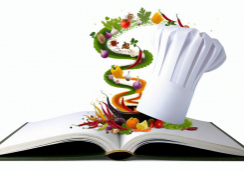Chef-Approved Guide to Crafting Recipes With Fresh Produce
In the culinary world, a ripe, succulent peach and a can of peach syrup stand worlds apart, yet both can find their place in a kitchen; it's the former, however, that can truly elevate your cooking to new heights.
As a home cook, you've likely experienced the allure of fresh produce—its vibrant colors and textures beckoning from market stalls. But harnessing these qualities in your recipes requires more than just a trip to the local farmers' market. You need to know not only how to select the best of the bunch but also the techniques to let their natural flavors shine through in your dishes.
In this chef-approved guide, we'll walk you through the essentials of crafting recipes that bring out the best in fresh produce, touching on everything from understanding seasonal availability to mastering the art of flavor pairing.
So, if you're eager to transform your simple ingredients into a symphony of tastes that can impress even the most discerning palates, let's begin peeling back the layers of possibility that these earth-grown treasures offer.
Understanding Seasonal Availability
To maximize flavor and sustainability in your cooking, it's crucial to know which fruits and vegetables are in season in your area. By tuning into the rhythm of the seasons, you're not only treating your taste buds to peak freshness but also supporting local ecosystems and economies. Imagine biting into a juicy peach in the height of summer or savoring a crisp apple come fall—these moments hinge on seasonal availability.
When you align your meal planning with the ebb and flow of nature's offerings, you unlock the potential for great recipes that sing with vibrancy. The sweet, concentrated flavors of vine-ripened tomatoes in the summer can transform a simple pasta dish into a mouthwatering masterpiece. In contrast, the earthy roots and squashes of autumn provide a comforting warmth to hearty stews and roasts.
Seasonal produce isn't just about indulging in the best taste—it's also a smart move for your wallet. Abundance typically means lower prices, so you can fill your kitchen with nature's bounty without breaking the bank. Plus, with a reduced need for long-distance transportation, you're contributing to a smaller carbon footprint.
Embrace the diversity that each season brings to your table. Let the natural cycle of the earth guide your culinary journey, and watch as your dishes come alive with the fresh, bold flavors of the moment.
Selecting Quality Ingredients
Having embraced the seasonal rhythms in your meal planning, you'll now want to focus on selecting the freshest and most flavorful ingredients available. In New England, the bounty of each season offers a palette of tastes and textures that can inspire any dish. When you're at the market, let your senses guide you. Look for fruits and vegetables that are vibrant and rich in color, a tell-tale sign of freshness and, often, a peak in nutritional value.
Touch is just as crucial—produce should be firm to the touch, not limp or excessively soft. Give that tomato a gentle squeeze; it should yield slightly, its skin smooth and unblemished. Inhale the sweet, earthy scent of fresh basil or the invigorating aroma of mint. These olfactory cues signal freshness and can elevate your culinary creations.
For protein, the principles of selecting quality ingredients remain the same. Seek out food products from local farms where possible, ensuring you're getting the freshest meat, poultry, or seafood. A good piece of fish will have a clean ocean scent, and the flesh should be resilient when pressed. The marbling on meats should be consistent, promising juiciness and flavor.
Flavor Pairing Fundamentals
Unlock the full potential of your dishes by mastering the art of flavor pairing, a technique that enhances and complements the natural tastes of your ingredients. By understanding how different flavors work together, you'll craft new recipes that aren't only balanced but also brimming with taste.
Here's how you can start experimenting with flavor combinations in your new dishes:
- Sweet and Savory Synergy: Combine sweet fruits like peaches or apples with savory herbs such as rosemary or thyme to create a dish that sings with complexity.
- Contrasting Complements: Pair tangy citrus or vinegars with sweet honey or maple syrup for a zesty contrast that excites the palate.
- Balanced Bites: Mix salty cheeses with bitter greens like arugula or radicchio to achieve a dish that's both well-rounded and deeply satisfying.
When these fundamental principles are applied, your meals will transform into memorable culinary experiences. Flavor pairing isn't just about making food taste better; it's about creating layers of flavor that intrigue and delight.
Dive into the art of flavor pairing and watch as your fresh produce becomes the star of innovative and appetizing masterpieces.
Are Local Ingredients Essential for Crafting Recipes with Fresh Produce?
When crafting recipes with local produce, using local ingredients is essential for capturing the true flavors of the region. Local ingredients ensure freshness, quality, and authenticity, adding a unique touch to any dish. Supporting local farmers and businesses also contributes to sustainability and community growth.
Recipe Structure and Balance
Embark on a journey of culinary harmony by piecing together a well-structured recipe, where balance in flavors, textures, and techniques elevates your fresh produce to create a truly harmonious dish.
When making recipes, start with a solid foundation—a base that could be a succulent protein, a hearty starch, or a vibrant vegetable. Introduce a sauce or seasoning to enhance and complement the natural tastes of your produce. A well-crafted dressing or spice mix can transform the mundane to the sublime.
As you test recipes, pay close attention to the interplay of sweet, salty, sour, and bitter flavors. This balance is crucial for crafting a dish that sings with flavor. Be mindful of ingredient proportions to achieve the perfect taste and texture. A sprinkle of salt, a dash of acidity, or a hint of sweetness can make your vegetables pop.
Preservation Techniques Integration
Integrating preservation techniques like canning, pickling, and fermenting into your cooking repertoire can transform your seasonal harvests into a treasure trove of flavors, accessible any time of the year. These methods not only extend the shelf life of your fresh produce but also enhance your dishes with intriguing tastes and textures.
Here are a few ways to make the most out of preservation techniques integration:
- Canning: Preserve the peak ripeness of fruits and vegetables in jars to capture summer's sweetness or autumn's earthiness. Use them later as vibrant additions to sauces, stews, or as standalone sides.
- Pickling: Quick-pickle cucumbers, onions, or even radishes for a zesty crunch in salads, sandwiches, or as garnishes. The tangy bite of vinegar-based brines can elevate the simplest of meals.
- Fermenting: Create rich, complex flavors by fermenting cabbage into sauerkraut or transforming carrots into spicy kimchi. These probiotic-rich additions can boost both the healthfulness and the savoriness of your meals.
Conclusion
Now you're equipped to let fresh produce shine in your kitchen! Remember, picking seasonal ingredients at their peak guarantees the most flavorful dishes. Trust your senses when choosing produce, and don't be afraid to mix and match flavors.
Create balanced recipes that highlight your vibrant veggies and fruits, and when you've got too much goodness, employ clever preservation to savor every bit.
Dive in, experiment, and most importantly, enjoy the bountiful delights of your culinary creations!










